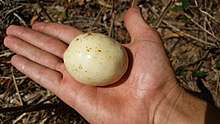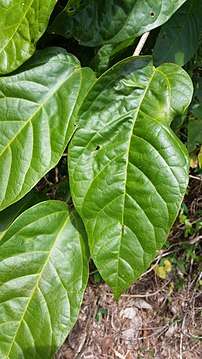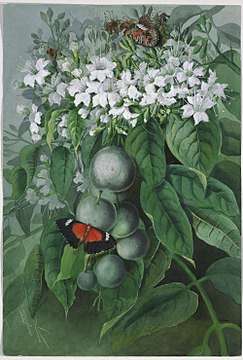Faradaya splendida
Faradaya splendida is an evergreen vine in the family Lamiaceae which produces white, fragrant flowers and white, egg-shaped fruit. It naturally is occurs in the tropical rain forests of tropical Asia and Australia and is often sighted along rain forest margins such as roads. Some common names include October Glory, Glory Vine, Potato Vine and Fragrant Faradaya.[2] Australian indigenous names for F. splendida include Garanggal used from Cairns to Yarrabah, Buku used in the Tully River area, Koie-yan used at Dunk Island and Djungeen used by the Girramay clan.[2]
| Faradaya splendida | |
|---|---|
 | |
| Faradaya splendida fruit on palm of hand | |
| Scientific classification | |
| Kingdom: | |
| (unranked): | |
| (unranked): | |
| (unranked): | |
| Order: | |
| Family: | |
| Genus: | |
| Species: | F. splendida |
| Binomial name | |
| Faradaya splendida | |
| Synonyms | |
| |
Description
The woody, twining, evergreen, Liana vine can grow up to 15 cm in diameter.[3][2][4] The ovate, glossy green leaves can grow to 24 cm long and 13 cm wide.[4][5] The leaves are attached to the vine in pairs or triples with stems, petioles, up to 8 cm long.[4][3] F. splendida flowers and fruits in the warmer months from August to April.[2][6] The white, fragrant flowers are abundant but short lived, sometimes lasting only a single day.[2] Each flower measures about 4.5 cm in diameter. The fruit is white and fleshy with a single large seed. The fruit resembles a potato or large egg which is 8 cm long and 5 cm in diameter.[4] The rough and brown seed coating is 1 to 3mm thick and covers a smooth seed.[3]
Taxonomy
The species was formally described in 1865 by Victorian government botanist Ferdinand von Mueller in Fragmenta Phytographiae Australiae based on plant material collected by John Dallachy near Rockingham Bay.[1] This was the first species to be included in the family Faradaya.[3] The name of the genus, Faradaya, pays tribute to the late scientist Michael Faraday. The species name, splendida, refers to the glossy sheen of its dark green leaves.[2]
Many species in the genus Faradaya have found to be synonymous with F. splendida. For example, F. albertisii, F. splendida and F. dimorpha var. cauliflora were considered different species based only on whether the inflorescence was lateral, terminal or cauliflorous. Newer observations found that the different types of inflorescence is found at different stages of the flowering event.[3]
Distribution and habitat
F. splendida occurs in Indonesia, Malaysia, Papua New Guinea, the Solomon Islands and Queensland in Australia.[7] It can be found in rain forest, hill forest and swamp forest from sea level to 2000m. The tolerant vine can grow in clay and humus, and can inhabit both undisturbed, primary forest and previously disturbed, secondary forests.[3][4] It is common to see the white fruited vine along rain forest margins such as roads.[5]
Ecology
For several Australian butterflies, F. splendida is a larval food plant. Those butterflies include Pseudodipsas eone, Hypochrysops miskini, Shining Oak-blue, Hypolycaena phorbas and Pale ciliate blue.[8] For at least P. eone, this butterfly will seek out F. splendida leaves specifically for the extrafloral nectaries. The nectaries found on the leaves produce nectare and P. eone will only feed one leaves with this characteristic.[9][10]
The Spectacled flying fox is a frugivore that eats F. splendida but is too small to consume and disperse the seed internally. It may disperse the fruit short distances by carrying the fruit.[11] The much larger Southern cassowary also feeds on F. splendida and the seed is one of the largest that the cassowary can ingest. This can disperse the seed over large distances.[12] The fruit and seed of F. splendida are both consumed by the Musky rat-kangaroo. The rat-kangaroo is too small to swallow the seed but will still eat it.[13]
F. splendida is one of the prominent vine species that thrive in heavily cyclone damaged forest, otherwise known as cyclone scrub. These areas of forest tend to have a low, uneven canopy level due to damage from local intensification of cyclonic winds where several vine species will grow into the canopy.[14]
Uses
F. splendida is grown as a decorative plant in gardens. Its flowers are attractive and have a pleasant fragrance. When provided with plenty of sunlight and water, the vine is hardy and grows vigorously.[5]
For the Australian Aboriginal Girramay clan, the Djungeen vine is an indicator plant. When the egg-like fruit falls to the ground in October, Bush Turkey nests will have eggs in them.[2]
Another aboriginal use of F. splendida is to poison fish. The outer bark is removed and the middle layer of the bark is scraped off, then rubbed onto a hot stone. When the stone is thrown into a creek or small lagoon, all marine animals in the water are poisoned and death occurs within an hour.[2][15][3] A sapotoxin is found in the leaves, stems and roots of F. splendida which is an effective fish poison. It will readily dissolve in water and is effective even in low concentrations.
Based on a word of mouth report, the fruit is said to be edible but is not desired.[2][15]
References
- "APNI - Faradaya splendida". biodiversity.org.au. Retrieved 9 December 2017.
- Freeman, Jenny. "Faradaya splendida | SLQ Today". SQL Today. The State Library of Queensland. Retrieved 8 December 2017.
- Kok, R.P.J. de; Mabberley, D.J. (1999). "The genus Faradaya (Labiatae)". Blumea - Biodiversity, Evolution and Biogeography of Plants. 44 (2). ISSN 0006-5196.
- Hyland, B. P. M.; Whiffin, T.; Zich, F. A.; et al. (Dec 2010). "Factsheet – Faradaya splendida". Australian Tropical Rainforest Plants (6.1, online version RFK 6.1 ed.). Cairns, Australia: Commonwealth Scientific and Industrial Research Organisation (CSIRO), through its Division of Plant Industry; the Centre for Australian National Biodiversity Research; the Australian Tropical Herbarium, James Cook University. Retrieved 18 July 2013.
- "Faradaya splendida". anpsa.org.au. Australian Native Plants Society (Australia). Retrieved 8 December 2017.
- Cooper, Wendy Cooper ; illustrated by William T (2013). Australian rainforest fruits : a field guide. Collingwood, Vic.: CSIRO Publishing. p. 206. ISBN 9780643107847.
- "Faradaya splendida". Germplasm Resources Information Network (GRIN). Agricultural Research Service (ARS), United States Department of Agriculture (USDA). Retrieved 18 July 2013.
- Braby, Michael F. (2004). The Complete Field Guide to Butterflies of Australia. CSIRO Publishing. ISBN 9780643099685.
- Atsatt, Peter R. (1 November 1981). "Lycaenid Butterflies and Ants: Selection for Enemy-Free Space". The American Naturalist. 118 (5): 638–654. doi:10.1086/283859. ISSN 0003-0147.
- Blüthgen, Nico; Reifenrath, Kerstin (2003). "Extrafloral nectaries in an Australian rainforest: structure and distribution". Australian Journal of Botany. 51 (5): 515–527. doi:10.1071/bt02108. ISSN 1444-9862.
- Richards, G. C. (1990). "The spectacled flying fox, Pteropus conspicillatus (Chiroptera: Pteropodidae), in north Queensland. 2. Diet, seed dispersal and feeding ecology". Australian Mammalogy. Australian Mammal Society. 13: 25–31.
- Stocker, G. C.; Irvine, A. K. (1983). "Seed Dispersal by Cassowaries (Casuarius casuarius) in North Queensland's Rainforests". Biotropica. 15 (3): 170–176. doi:10.2307/2387825. JSTOR 2387825.
- Dennis, A. J. (2002). "The diet of the musky rat-kangaroo, Hypsiprymnodon moschatus, a rainforest specialist". Wildlife Research. 29 (2): 209–219. doi:10.1071/wr00052. ISSN 1448-5494.
- Webb, L. J. (1958). "Cyclones as an ecological factor in tropical lowland rain-forest, North Queensland". Australian Journal of Botany. 6 (3): 220–228. doi:10.1071/bt9580220. ISSN 1444-9862.
- Banfield, E.J. (1918). Tropic days. London T. F. Unwin, ltd. p. 196.


